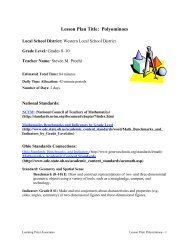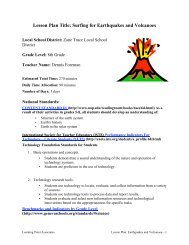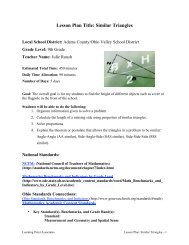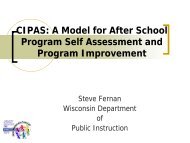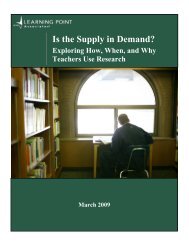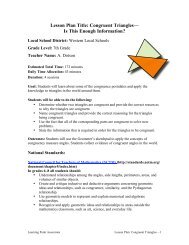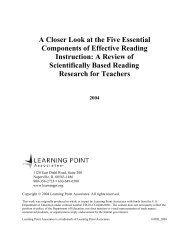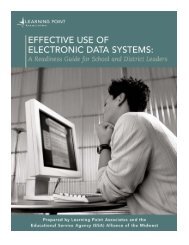Lesson Plan Title: Rising Water! - Learning Point Associates
Lesson Plan Title: Rising Water! - Learning Point Associates
Lesson Plan Title: Rising Water! - Learning Point Associates
You also want an ePaper? Increase the reach of your titles
YUMPU automatically turns print PDFs into web optimized ePapers that Google loves.
<strong>Lesson</strong> <strong>Plan</strong> <strong>Title</strong>: <strong>Rising</strong> <strong>Water</strong>!Local School District: Symmes ValleyGrade Level: Grades 3–5Teacher Name: Melinda BodmerEstimated Total Time: 50 minutesDaily Time Allocation: 1 day/class periodDuration: 1 dayNational Standards:CONTENT STANDARD B: (http://www.nap.edu/readingroom/books/nses/6c.html#csck4)As a result of the activities in grades K–4, all students should develop an understanding of:• Properties of objects and materials• Position and motion of objects• Light, heat, electricity, and magnetismCONTENT STANDARD B:As a result of their activities in grades 5–8, all students should develop an understanding of:• Properties and changes of properties in matter• Motions and forces• Transfer of energyBenchmarks and Indicators by Grade Level(http://www.genevaschools.org/standards/#science)<strong>Learning</strong> <strong>Point</strong> <strong>Associates</strong><strong>Lesson</strong> <strong>Plan</strong>: <strong>Rising</strong> <strong>Water</strong>—1
Ohio Standards Connections:Science Academic Content Standards(http://www.ode.state.oh.us/Academic_Content_Standards/acsscience.asp)• Key Standard(s), Benchmarks, and Grade Band(s):Standard: Physical Science (3–5)o Identify and describe physical properties of matter in various states.(http://www.school-for-champions.com/science/matterstates.htm)D. Summarize ways changes in temperature can be produced and thermal energytransferred.Grade Level Indicators:Standard (4): 4. Explain that matter has different states (solid, liquid, gas), and each havedistinct physical properties.5. Compare ways temperature of objects can be changed (rubbing, heating,bending of metal).Standard (3): 5. Record, organize, observations in journals, tables, and charts.Standard (5): 3. Use evidence of observations to explain and communicate results ofinvestigation.Mathematical/Scientific Processes:Grades (3–5): Recording (journals, charts, tables), organizing, observing, predicting, estimating,controlling variables, measuring, comparing, scientific method, and inquiry.Other Related Benchmarks• Standard: Science Inquiry (3–5): B. Organize/evaluate observations, measurements,and other data to formulate inferences/conclusions.<strong>Lesson</strong> Summary:Describe what students will know, understand, or be able to do after this lesson.Students will watch water change from its liquid state into its gaseous state when it is heated,then back to its liquid state when cooled. Students will learn that gas molecules move faster thanliquid molecules; this causes expansion and pressure, and requires more space for the gaseousstate of liquids. Students will learn the physical properties that describe how water behaves,feels, appears, and that those properties change when water is either heated or cooled.Preassessment:Describe how you will indicate what knowledge/skills students already have related to theconcepts being taught in this lesson.Students will be asked in open discussion prior to the lesson what they already know about howwater behaves, appears, feels, and what they have seen water do in everyday life. Examples:Evaporation from a water puddle outside, changing from liquid to gas; change to an icicle inwinter; if they have ever boiled water and noticed the form or condition or state the water is inwhile in the pan, and the condition water is in as it rises from the pan; noticed a mirror in the<strong>Learning</strong> <strong>Point</strong> <strong>Associates</strong><strong>Lesson</strong> <strong>Plan</strong>: <strong>Rising</strong> <strong>Water</strong>—2
athroom after taking a hot shower; or found the need to warm up dishwater. Discussion willlead to stages of the water cycle, physical properties of water in each state, gas expansion, andtransfer of energy. Encourage students to participate with answers and relative life examples.• Scoring Criteria: All students receive 5 bonus points for participation in open discussion.Postassessment:Describe how you will determine the level of student understanding of the concepts in the lesson.Students will be given a stated question at the beginning of the lesson, about which they willform and record a hypothesis. After going through the steps of the experiment, analyzing results,and small cooperative group discussions, students will draw conclusions about what hashappened and conclude upon the question asked in the beginning. Open, full-group discussionwill follow concerning the results and conclusions, and misconceptions will be corrected.Students will then be given a brief set of key vocabulary words to use in answering a similarsituation as follows: (This may be done as a homework assessment if time is not available.)Key words: expansion, gas, evaporation, heat, particle movement of waterExample Situation: Tim’s fourth-grade science class did the <strong>Rising</strong> <strong>Water</strong> experiment as youjust did. Tim wanted to see if the class conclusion would hold true for other liquids. Tim askedhis teacher if he could perform an experiment to test the class conclusion using another liquid.His teacher suggested he use alcohol with red food coloring in it, and she helped Tim set up theexperiment. Tim said he would use a plastic bottle to place the alcohol in. Tim marked the plasticbottle with a black line to show the 150 ml measurement, measured the alcohol and foodcoloring to 150 ml, and poured the solution into the bottle. Tim placed the lid onto the plasticbottle tightly and put the bottle outside the classroom window in the sun. One hour later, Timand his teacher checked the bottle. Tim found the sides of the plastic bottle were pushed outward.Tim’s results with the alcohol and food coloring were similar to the class results with water andthe bottle. Tim concluded that other liquids also behave the same when treated in similar ways.Students are required to answer the following questions after reading the example situationabove. These questions will be scored according to the rubric below.4-point extended response question: Use at least 3 of the key words given above in the keyword list to explain how the Tim’s experiment is like the <strong>Rising</strong> <strong>Water</strong> experiment you did inclass.• Scoring Criteria:4-point score: At least three words used correctly to explain that the sun created heat thatwas trapped inside the plastic bottle. The heat caused some of the liquid to evaporate insidethe bottle, changing from liquid alcohol to gas. The heat also warmed up the air inside thebottle. The gases of air and evaporated rubbing alcohol expanded out, and sped up inmolecular movement, causing the gases to need more space. This was like our <strong>Rising</strong> <strong>Water</strong>experiment because the water in the glass bottle became warmed, evaporated, and the airwarmed inside the bottle. The gases of air and water in our experiment pushed down on the<strong>Learning</strong> <strong>Point</strong> <strong>Associates</strong><strong>Lesson</strong> <strong>Plan</strong>: <strong>Rising</strong> <strong>Water</strong>—3
liquid forcing the water to rise up the straw. The gases of alcohol and warm air in Tim’sexperiment pushed on the sides of the plastic bottle and forced the sides outward. (Anystudent response that uses three words correctly and relates to three similarities between thetwo experiments correctly should receive a four-point score. Students may describe conceptsof evaporation, expansion of gas, heating of air and liquids, transfer of energy.) Studentsmay also use pictures, Venn diagrams, or comparison charts of the two experiments toexplain question.3-point score: Two words used correctly and students refer to two comparable details asstated above.2-point score: Two words used correctly and students refer to one way the two experimentsare alike.1-point score: One word used correctly and one concept at least mentioned, but not fullyexplained. May not show comparison of two experiments.0-point score: Student did not attempt to answer the question.• Short Answer Response2-point short answer question: Two different types of bottles were used for these twoseparate experiments. One bottle was glass and one was plastic. Compare the characteristicsof these two materials and explain why Tim chose to use a plastic bottle for his experiment.2-point score: Student lists at least one characteristic of glass and one of plastic, explainingthat plastic is soft, or bendable and moveable. Tim used plastic because he knew if a gasformed the plastic bottle would bulge out to show the expansion of the gas, and Tim couldnotice the evidence of formation of the gas. Picture drawings are acceptable for comparisonif they are labeled to show a plastic bottle bulging and characteristics of glass and plastic.1-point score: Students give at least one characteristic of plastic, explaining that plastic issoft, or can be pushed out or in. Student attempts to explain the formation of gas inside theplastic bottle can be identified.0-point score: Student makes no attempt to answer the question.Multiple-choice questions: Will temperatures of liquid molecules cool down, warm up, orstay the same if a liquid is changed into a gas? (1-point question)a. Temperature of liquid molecules cools down when changing to a gas.b. Temperature of liquid molecules warms up when changing to a gas.c. Temperature of liquid molecules stays the same when changing to a gas.<strong>Learning</strong> <strong>Point</strong> <strong>Associates</strong><strong>Lesson</strong> <strong>Plan</strong>: <strong>Rising</strong> <strong>Water</strong>—4
Material and Resources Needed:Products that need to be copied, collected, or created. Use box to indicate status.Food coloring<strong>Water</strong>Glass bottles with a screw-top lidNarrow strawsClay teapotScissorsHotplate (method for heating water)Large bowls to hold glass bottle and waterSafety gogglesPotholdersThermometersCupsIndividual student <strong>Rising</strong> <strong>Water</strong> Journals written as formatted below:Journals:<strong>Title</strong> of <strong>Lesson</strong>: <strong>Rising</strong> <strong>Water</strong>What do you already know about water? Name some physicalcharacteristics of water, describing below how water looks, feels, and behaves. Draw apicture of something you have seen water “do” before.Question: How will water molecules behave when the temperature of thewater changes from cool or cold to much warmer?Hypothesis:Observations – Comments:Results:Conclusion:Assessment: (Teacher to record Tim’s similar example experiment and keyword list here forstudents to respond to.)Procedures:Describe step-by-step instructions for the illustrative activities and specific methods fordeveloping the lesson.(This can be done by teacher demonstration or in small groups when group jobs have beenassigned.)1. Safety: (http://csss.enc.org/safety) Review safety rules about hot water and use ofsafety goggles. Explain cooperative group rules and expectations. Teacher to make ahole in the bottle caps to fit the narrow straw for each student.<strong>Learning</strong> <strong>Point</strong> <strong>Associates</strong><strong>Lesson</strong> <strong>Plan</strong>: <strong>Rising</strong> <strong>Water</strong>—5
2. Motivation: Ask students to tell about every day things they have noticed about howwater behaves, looks, and feels. Tell students these are called the physical propertiesof water. Record into journals.3. Review Scientific Method,(http://school.discovery.com/sciencefaircentral/scifairstudio/handbook/scientificmethod.html) explaining that we will be doing an investigation with water beginning witha question that is recorded in their journals. Question: How will water moleculesbehave when the temperature of the water changes from cool or cold to muchwarmer?4. Form a Hypothesis.5. Ask how we could find out an answer to our question. (Heat or freeze the water.)6. Form groups. Wear safety goggles, use potholders when touching the bowl with hotwater, and begin experiment. Teacher is to heat and pour water for students. <strong>Water</strong> tobe hot, but not boiling. One student from each group should gather materials.7. Fill glass bottles with cold water, pour some of the cold water into a cup, place athermometer in the cup (one for each group), and record temperature of cold water.Add food coloring to the water in the bottles; recap bottles with the lid with the holein it. Push the narrow straw into the lid and water. Press clay around the straw andseal it. As students pour cold water into the bottles, ask: “Is there anything else in thebottle besides water?” (Air)8. Plug straw with the clay.9. Pour hot water into large bowl. Place thermometers into hot water, and recordtemperature. Place bottle into the hot water bowl. Pour more hot water onto the bottle.10. Observe how the colored water in the bottle begins to behave. Record everything younotice as RESULTS in your journals. Watch it for several minutes.11. Ask: “Why do you think the water begins to move and then to rise and spray out thestraw?” Have students talk like a scientist, using proper vocabulary. Students shouldtalk in groups to discuss events and reasoning.12. Present key words: expansion, gas, heat, evaporation, and particle movement.Challenge groups to use key words and justify their reasoning with one another forthe waters behavior. Set timer for 5 minutes. Groups are to choose a spokespersonthat will use as many of the key words as possible to explain the reason for thespraying straw.13. Ask: “Why did we take the temperatures of the cold and hot water?”14. Observe the differences between the cold and hot water temperatures. Ask: “What doyou estimate that the temperature of the water is now inside the bottle?” Recordestimated temperature. Using one student’s bottle of water, measure the temperature.Discuss why the temperature is now higher. Explain TRANSFER OF ENERGY;(http://www.linkslearning.org/Teachers/3_Science/2_Strand_Maps/2_Transfer_of_Energy/) heat energy from the hot water was transferred to the colder water until thetemperature of the water inside the bottle became nearly equal to the water in the<strong>Learning</strong> <strong>Point</strong> <strong>Associates</strong><strong>Lesson</strong> <strong>Plan</strong>: <strong>Rising</strong> <strong>Water</strong>—6
owl. Explain that also some of the water inside the bottle has been changed toanother form than liquid. Ask for volunteer responses to tell what form other thanliquid water is inside the bottle. (Gas)15. Conclusion: The water begins to spray out of the straw because the hot water in thebowl warms the air and the liquid inside the bottle. The liquid water begins toevaporate, changing into a gas and taking up more space. Gas molecules move fasterthan liquid molecules, so they need more space. When the air is warmed, it expandstoo. The expanded air and water vapor (gas) are both now moving faster as gases andthey need more space, so they are pushing down on the liquid water in the bottle,forcing the water to rise up the straw. Therefore, when the temperature of watermolecules is changed, water will change its state from liquid, solid, or gas, dependingon if the water is heated or cooled.Differentiated Instruction Strategies: (http://www.teach-nology.com/tutorials/teaching/differentiate/bottom_line/)Describe changes that may be needed in depth, breadth, and pace of the lesson to accommodateunique learner needs.• Intervention: Students that may not be grasping concepts may be placed with a singlestronger partner during the experiment, draw pictures in sequence, use short captions,circle correct key words to show understanding. Gifted students may design otherexperiments showing key concepts and perform them. Students that are struggling maybe chosen to perform particular parts of the experiment during the class time, or mayrepeat steps if necessary.• Enrichment: Challenge students to look for examples of liquids changing state ineveryday life (icicles melting, water puddles evaporating, and fog forming on glass).Challenge students to explain the water cycle and how we get our rain.Extension:Describe how newly gained knowledge, understanding, or a skill can be extended throughcontext or application.How does boiling water show the concept of expansion? Make a small greenhouse to showtransfer of energy.Homework Options and Home Connections:Using a small lid from an empty jar, fill the lid half-full with water and pour in ¼ teaspoon ofsalt. Sit the lid in a windowsill for two days and observe what happens each day. Write a shortexplanation of what happens to the water, what is left behind, and why some material is leftbehind.<strong>Learning</strong> <strong>Point</strong> <strong>Associates</strong><strong>Lesson</strong> <strong>Plan</strong>: <strong>Rising</strong> <strong>Water</strong>—7
Key Vocabulary:• Physical properties (http://www.physicalgeography.net/fundamentals/8a.html)• Expansion• Temperature (heat)• Particle movement• Matter• Evaporation• Liquid• Solid• Gas• Transfer of energy (http://www.linkslearning.org/Teachers/3_Science/2_Strand_Maps/2_Transfer_of_Energy/)Technology Tips:Allow students to go to Web sites to research the water cycle (http://www.kidzone.ws/water/)and weather.General Tips:Do a lesson or two on matter prior to this lesson. Have students practice with cooperative groupwork and scientific method prior to this lesson.Research Connections:Physical science lessons (http://school.discovery.com/lessonplans/physci.html)Space Science (http://spacescience.nasa.gov/)This lesson came from an ohiorc.org. Web site called “FOUNTAIN IN A BOTTLE,” and I havemodified it immensely with scientific method, assessment, scoring, enrichment, extension, and modifications to the procedure.Teacher Reflections and Notes:This lesson can be extended in many ways, going into the water cycle; how measurements,observations, records of students vary from one person to another in an experiment; the need fordoing experiments more than one time for accuracy, etc. The assessment piece could be done as ahomework assignment if time is too limited in class.Other Web Resources:http://www.gecdsb.on.ca/d&g/scitech/science/strands/mm5.htmhttp://www.miamisci.org/af/sln/phases/waterliquid.htmlhttp://www.chem4kids.com/files/matter_intro.htmlhttp://www.uen.org/<strong>Lesson</strong>plan/preview.cgi?LPid=631http://www.sciencenetlinks.com/index.cfmhttp://www.school-for-champions.com/science/matterstates.htm<strong>Learning</strong> <strong>Point</strong> <strong>Associates</strong><strong>Lesson</strong> <strong>Plan</strong>: <strong>Rising</strong> <strong>Water</strong>—8




